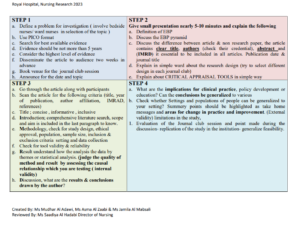By Mudhar Al Adawi, Senior Nurse, Nurse Researcher at Royal Hospital, Oman.
Evidence-based practice (EBP) has become a global issue among health care providers due to improvements in the quality of health systems. Acquired knowledge from EBP helps to improve patient outcomes, guide clinical practice, and improve the quality of care for the healthcare consumer or partner1. The adaptation of EBP varies from one institution to another. One strategy that we used to adapt the EBP at Royal Hospital, Oman, was the journal club. A journal club is an informal meeting of a small professional group to review or critique literature 2. However, there are numerous facilitators as well as barriers toward EBP and journal club implementation. Supportive hospital culture as well as mentorship promote EBP and enable nurses to practice being evidence-based 3. On the other hand, a lack of power and authority to change practice could hinder the utilization of the best evidence4.
In Oman, nurses are required to be lifelong learners. This is in our professional conduct for nurses and midwives and this learning process can be achieved by attending courses and conferences to acquire the latest and best available evidence. Moreover, it emphasizes that organizations are required to provide mandatory training programs for nurses to be competent5.
At Royal Hospital, Oman, as part of the implementation of EBP, journal clubs were established and closely monitored by an expert researcher. Journal clubs have been found to be effective in implementing EBP6.As a starting step, we aimed to keep nurses abreast of latest literatures and develop critiquing skills. Therefore, we started by structuring a series of educational sessions and workshops on journal clubs and EBP. A group of nurses – research mentors were assigned for each unit in the hospital. Administration support, clear expectations, and empowering the nurses to communicate changes were communicated with each research mentor. A handout summarizing journal club steps was developed and distributed to all nurses through the hospital portal. This was found to be useful for all nurses to follow and conduct the journal club sessions. These handouts were used by all research mentors after attending a special session explaining the steps of journal club, how to use the handouts, and a practical session of the critical appraisal process. We followed up each research mentor for measures such as number of journal clubs conducted, number of attendees for each session, and progress was communicated with the hospital administration. Since then, there has been a tremendous increase in the number of journal club sessions conducted within 2023 (47 sessions conducted with 815 attendees).
Figure 1 Journal club handout
As a result of these series of journal clubs, nurses were empowered in terms of knowledge translation, and were able to identify practice gaps and find evidence-based practice solutions in their clinical settings. Currently, and as a result of journal clubs, the majority of our organisations’ nursing guidelines and policies are being updated by research mentors using the latest evidence. Moreover, improvement projects were initiated as a result of journal club sessions. One example is the nursing practice of pain management. Prior to the journal club, the research mentors surveyed patients to assess nurses’ performance on pain assessment and management. Patients rated 42% satisfaction and a 50% compliance rate with pain assessment and management by nurses. Then a series of journal clubs that focused on pain assessment and management were targeted, and interventions based on the best evidence were applied. Post-journal club sessions, the patient satisfaction rate increased to 62%, and nurses’ compliance toward assessment and management increased to 80%.
Consequently, these outcomes lead me to encourage other organizations to adopt the journal club approach, set clear expectations, have research mentors at each unit, and create a supportive environment toward research and development. Having all these steps will ensure an effective approach to engaging nurses in EBP and changing practice for the benefit of patients.
References:
- Barbara A. Brunt, Melanie M. Morris. StatPearls [Internet]. 2023. Nursing Professional Development Evidence-Based Practice.
- Eusuf D, Shelton C. Establishing and sustaining an effective journal club. BJA Educ. 2022 Feb 1;22(2):40–2.
- Häggman-Laitila A, Mattila LR, Melender HL. A Systematic Review of Journal Clubs for Nurses. Vol. 13, Worldviews on Evidence-Based Nursing. Blackwell Publishing Ltd; 2016. p. 163–71.
- Pitsillidou M, Roupa Z, Farmakas A, Noula M. Factors Affecting the Application and Implementation of Evidence-based Practice in Nursing. Acta Informatica Medica. 2021;29(4):281–7.
- Ministry of Health. Principles of Code of Professional Conduct for Nurses in the Sultanate of Oman 2019 [cited 2023 Dec 17]. Available from: https://www.moh.gov.om/documents/106926/2918442/Principles+of+Code+of+Professional+Conduct+for+Nurses+in+the+Sultanate+of+Oman/d452d811-c765-473b-90b7-66d4761a028d
- Valizadeh L, Zamanzadeh V, Alizadeh S, Namadi Vosoughi M. Promoting evidence-based nursing through journal clubs: an integrative review. Journal of Research in Nursing. 2022 Nov 1;27(7):606–20.
This blog is part of a series in collaboration with the International Network for Health Workforce Homepage | International Network for Health Workforce Education (inhwe.org)

